Writing a SEO title (also called page title or Google title) is considered difficult because you are writing for 3 main audiences.
Visitors coming from search engines.
Search engines.
Visitors from social media.
And writing a SEO title that ranks high on Google and gets shared on social media can often feel like mission impossible.
Luckily, it turns out it really isn’t as difficult as it sounds.
All you need to do is follow a few important rules.
What is a SEO title?
A SEO title or page title is a headline that is optimized to help your article rank on search engines such as Google and Bing.
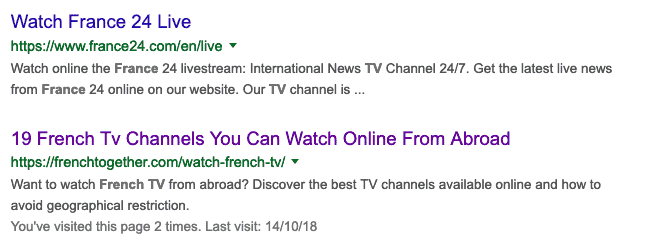
There are lots of criteria that make a headline a good page title but here are the 2 most important ones:
- Clearly communicate what the article is about.
- Make people want to click and read the article.
These 2 goals may seem contradictory and getting it right requires a bit of practice but you will get there if you follow the advice in this article.
What is a title tag? Is it the same as a SEO title?
While most people call the blog post title they write in Wordpress SEO title, it’s important to note that the title you write in Wordpress isn’t necessarily the one that will show up in Google.
That’s because Google first looks at a part of your page’s code called a title tag.
<title>Hello, I'm a title tag.</title>
The title tag is simply a line of HTML code that tells search engines what to show as a page title in the SERPS (Search Engine Results Pages.)
The SEO title is the title search engines like Google will show in the search results. This will often be the title tag you chose but search engines sometimes display another SEO title if they don’t think yours is a good fit.
Think of the title tag as a suggestion box for search engines. You tell them what SEO title you would like them to display but they may or may not follow your suggestion.
How can I change my article’s title tag?
If you are curious, you can view any page’s title tag by doing right click with your mouse (or ctrl right click) and clicking on “view source” or “view page source.” The exact wording will change depending on the browser and operating system you use but these instructions should work on most computers.
If you look at this page’s title tag, you will see that the title tag is the same as the article’s headline. It’s also the text displayed at the top of your web browser and serves as a quick description of each opened tab’s content.
But your SEO title won’t always be the same as your blog title and there are times when you will want your SEO itle to be:
- Shorter (so it displays fully in the SERPS.)
- More descriptive (so people know why they should click.)
If you followed the advice in my SEO guide and installed Yoast SEO, the plugin will automatically use your Wordpress article title as a title tag.
You can also change your title tag in the Wordpress editor if you would like it to be different from your blog post title.
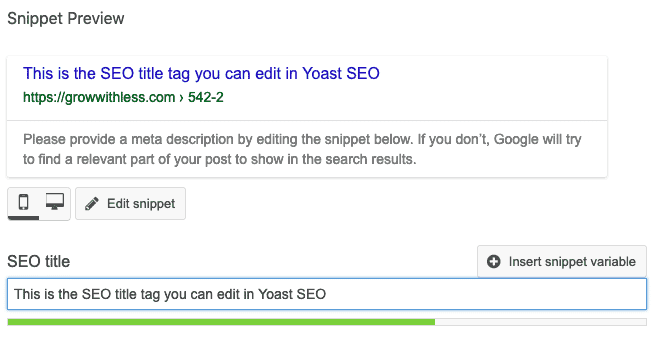
How to create a SEO title
Understand where people are coming from
To write a good page title, you need to first understand your readers’ search intent, that is what they expect to find when they type a keyword in their favorite search engine.
When people search “Italian food”, do they expect to find italian recipes? Are they looking for an Italian restaurant to eat in? Are they trying to learn more about Italian cuisine in general?
These are questions you need to answer before you even start writing your SEO title because they will determine the focus of your headline.
In fact, I would argue these are questions you need to answer before you even start writing your article.
To answer these questions, I recommend doing the following:
Google possible keywords
Type a few possible keywords in Google and see what the articles that rank first are about.
Google wants people to be happy with the results they see so you can safely assume that the articles at the top match the visitor’s search intent.
For example, if you type “electric razor” in Google, you will see (this may vary depending on where you are located and other factors):

- Questions people typing “electric razor” often ask.
- Links to several shops selling electric razors.
- An article listing the best electric razors to buy.
The search intent is clear: people want to buy an electric razor or at least get some advice before buying so your page title should be written for people who want to buy an electric razor or get advice.
- The best electric razors to buy in 2019.
- 10 places to buy the electric razor of your dreams.
- Is an electric razor really better?
Btw, the answer to the latest question is clearly no, a safety razor is not only more ecological and economical but shaves better.
Sorry, I feel like I’m slightly off-topic here.
Anyway, back to SEO titles :).
Use Google Autocomplete
Google Autocomplete or Google Suggest is the name of the Google search feature that shows you suggestions of alternative keywords when you type a keyword in Google.
In addition to being hilarious, Google suggestions are a goldmine showing you what keywords people searching for a term are likely to be interested in.
Here is what I see when I type “electric razor.”
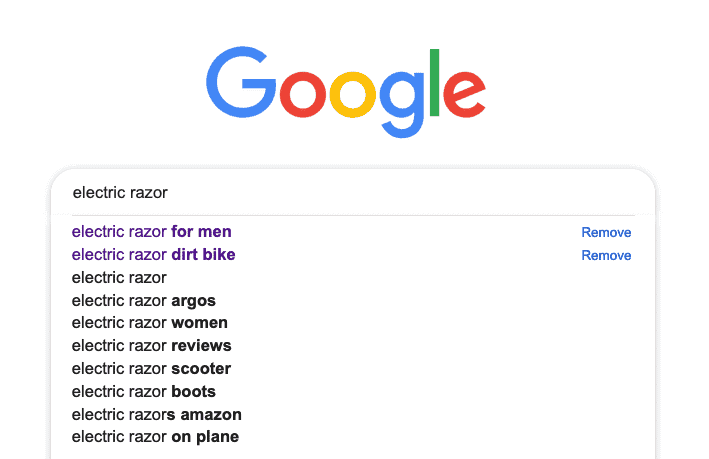
Most of the suggestions confirm that people who search “electric razor” are mostly looking for a razor to purchase but a few keywords may indicate another intent and may be worth looking into.
“Electric razor scooter” and “electric razor dirt bike”, for example, seem to refer to scooters made by a brand called Razor.
This is a sign that Google considers that there are 2 types of people who search “electric razor”:
- People who want to purchase an electric razor to shave.
- People who are interested in scooters made by the brand Razor.
Anyone reading your SEO title should be able to immediately tell which audience your article serves.
Clarity will not only make the right people more likely to click on your headline but will also help Google understand what your article is about and rank it accordingly.
If you look at the suggestions again, you will notice a few more interesting keywords such as “electric razor for man” and “electric razor for women.”
These suggestions show that Google knows that men and women are looking for different razors.
Instead of writing “The best electric razors to buy in 2019”, you could write “the best electric razors for men.” or “the best electric razors for women.”
This will make your SEO headline clearer for search engines and visitors and make you more likely to rank high in Google because Google will know your article is the right choice for the query.
If someone searches “electric razor for women” and your article is the only one mentioning “women” in the SEO title, Google is more likely to rank you higher because your article will seem more relevant.
Write your keyword in the SEO title (or not)
The best way to show that your article is a good match for a search query is to add your main keyword in the page title.
An article whose headline contains the word “electric razor” is clearly about well…electric razors whereas a headline like “This magic item helps me shave easily” is way less clear and could lead Google to wonder what the article is really about (and what term it should rank for.)
While placing a keyword as early in the SEO title as possible is generally considered good practice, I couldn’t find any evidence that this is genuinely useful.
In fact, some of the case studies I read indicate that you don’t even need to write your main keyword in the headline because Google is getting increasingly good at understanding synonyms and phrases.
If you type “Italian food Denver” in Google, you will notice that the top articles’ SEO titles don’t contain the keyword “Italian food Denver.”
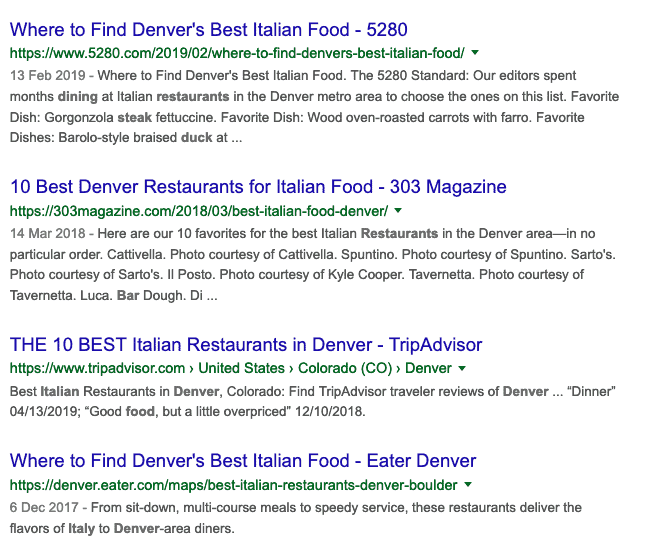
Instead, they use synonims or phrases that have a similar meaning. such as:
- Where to Find Denver’s Best Italian Food - 5280
- 10 Best Denver Restaurants for Italian Food - 303 Magazine
- THE 10 BEST Italian Restaurants in Denver - TripAdvisor
And that’s perfectly fine.
In fact, that’s probably better because people won’t click on a robotic-sounding headline and Google could consider the lack of clicks a hint that your article is not the right match for the query.
So my advice is simple:
Don’t obsess over keywords in your SEO title. If you can use your keyword in the headline without sounding robotic, great! Otherwise, simply use a synonim and make sure the topic of you article is clear from the headline alone.
Write a great headline
A SEO title doesn’t have to suck and sound robotic.
Even if you want your SEO headline to help your article rank high in Google search results, you need to keep in mind that your headline will ultimately be shown to real visitors.
Ranking number one doesn’t matter if nobody clicks to read your article.
So before you try to write a great SEO title, simply try to write a great blog post title.
Here are a few resources that could help:
- The headline writing checklist
- The Best Way to Come up with Catchy Blog Post Titles
- 77 Catchy Headline Formulas the World’s Most Popular Blogs Use
Be honest because Google is watching
It can be tempting to write a clickbait headline knowing that more people will click on it and come to your website but this would be forgetting about dwell time.
Dwell time is the time between when the reader clicks to visit a page and when he/she comes back to Google to look at other results.
Google most likely uses dwell time as a way to measure visitors’ satisfaction based on the idea that a happy visitor is likely to spend more time on a page while a unhappy visitor is likely to quickly go back and look at other search results.
This means that while a clickbait headline could temporarily lead to a higher ranking, Google will quickly figure out that there is something wrong and rank your article lower.
Choose the right SEO title length (or you may lose part of your headline)
There is no perfect title tag or page title length simply because Google will show more or less words in your SEO title depending on the device the visitor uses.
This said, Moz’s research on the topic indicates that keeping your title tags under 60 characters means that roughly 90% of people will see the entire headline.
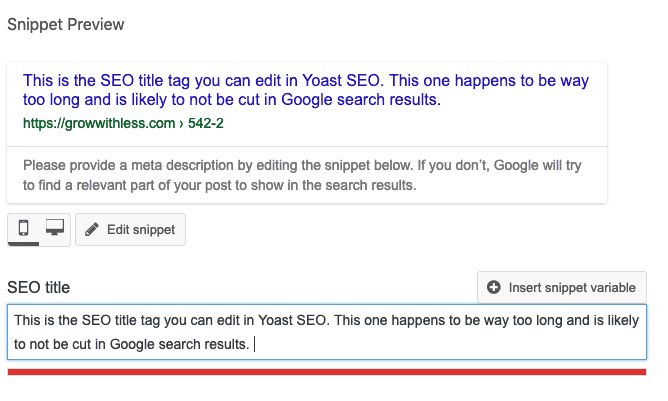
The Yoast SEO Wordpress plugin can help you figure out whether your SEO title is too long.
If you are not sure whether your SEO title is too long or not, you can use a headline analyzer like Coschedule or use Yoast SEO’s SERPS snippet preview function.
Over to you
You now have all the information you need to turn great headlines into great SEO titles.
Coming up with a SEO title that satisfies both Google and your readers is no easy task but it will get easier the more you practice.
So take a look at your existing page titles and see if you can rewrite them to make them more catchy.
Need inspiration? Here are 9 real SEO title examples!